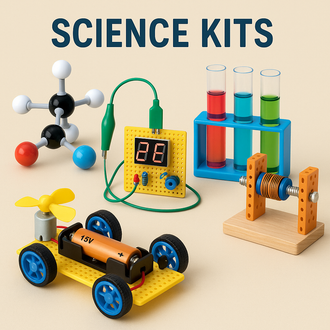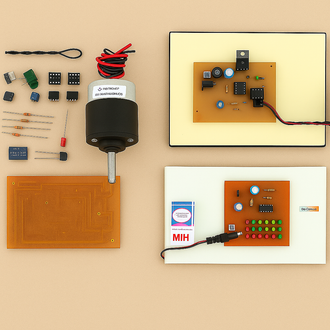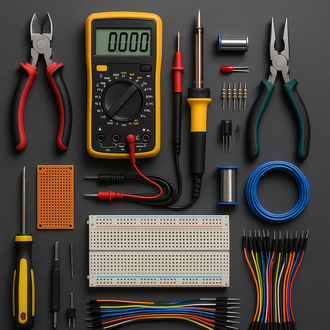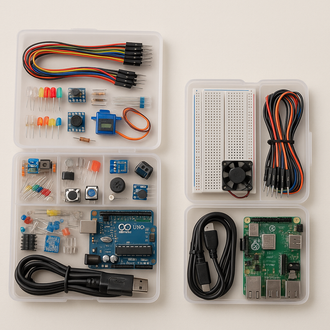
DIY Electric Scooter: How to Motorize a Kick Scooter with E-Bike Parts A Step-by-Step Guide
- 03 Nov, 2025
It's easier than you think to turn a regular kick scooter into a fast electric commuter. You can build a safe, efficient, and surprisingly cheap e-scooter with a strong deck, reliable wheels, and a few e-bike parts. This guide goes over how to plan, choose parts, mount, wire, tune, check for safety, and set a budget so that your build runs smoothly from the start.
1) Make a plan for your build: goals, terrain, and budget
First, decide how you'll use the scooter: for short trips around campus, last-mile commutes, or trips up the hill in your neighborhood. Flat urban routes are better for lighter systems and smaller batteries, while hilly terrain is better for systems with more torque and stronger brakes. Make a reasonable budget for the battery, drive kit, mounting hardware, and safety gear. If you want things to be as easy as possible, look into an electric scooter hub motor kit that comes with all the main parts.
2) List of Parts (Using E-Bike Parts)
- Motor wheel: Installing and aligning an electric scooter hub motor in the front or back is easier.
- Motor rating: A electric scooter motor 1000w is a good middle ground for DIYers who want fast acceleration without drawing too much current.
- Controller: A programmable electric scooter controller that works with your battery voltage and motor phase/hall connectors.
- Battery pack: a 36V or 48V lithium pack with BMS that can be mounted under the deck or on the stem.
- Throttle and display: You can use a thumb or half-twist throttle. An LCD screen shows speed, voltage, and error codes.
- Brakes: At least mechanical discs or V-brakes; hydraulic discs are better for heavier riders.
- Wiring harness: Hall/phase leads, brake cut-off levers, power leads, the main fuse, and connectors.
- Hardware: battery enclosure, loom/tape, rubber grommets, stainless fasteners, and torque arms/plates.
If you're worried about the cost, look into the different e scooter motor price ranges before you buy one. It's easier to keep track of which parts work with which kits, and they usually cost less than buying each part separately.
3) Pick the voltage, wheel size, and gearing
Voltage controls how fast something can go, while current controls how much torque it has. A 36V system is smooth and works well; a 48V system adds power for hills. The size of the wheels affects how they roll out. Bigger wheels ride smoother but need more torque to get going. Smaller wheels speed up quickly and keep the deck low. There is no external gearing for hub setups. You should choose the motor KV/winding that works best for your terrain (torque windings for hills and speed windings for flat areas).
4) Deck, Fork, and Frame: Strength Comes First
Kick scooters aren't made to handle motor torque by default. Add an aluminum or steel plate to the deck where the battery mounts to make it stronger. Check that the fork dropouts are thick and parallel. If you have hub motors, add torque arms to stop axle spin-out. Add a cross brace if your deck is flexible. Make sure all the cables are secure so the steering is light and doesn't get stuck.
5) Putting in the motor
Most builders say that installing the front hub is the easiest way to go. They take off the front wheel, slide in the hub motor axle, add torque washers and arms, center the wheel, and then tighten the nuts to the right amount. Make sure the brakes line up with the rotor (disc) or pads (rim). If you choose a rear hub, make sure there is enough space between the chainline and the fender mounts. Run the motor phase and hall wires up the fork leg with protective sleeving to keep them from rubbing against each other.
6) Mounting the battery and the case
Mounting under the deck keeps the weight down and makes it easier to handle. Use a sealed box with holes for air to flow out of the bottom, closed-cell foam to absorb shocks, and rubber gaskets for wires to exit. It's okay to use stem- or bar-mounted packs for prototypes, but they can feel top-heavy. Make sure to strap them down well and keep the wiring neat. Put a main fuse (or breaker) near the positive lead of the battery.
7) Sensors, throttle, and controller
The controller is like the brain that turns throttle input into motor power. Put the unit in a place where it can let heat out, like on the bottom of the deck with a splash guard. Connect the display, hall sensor plug, throttle, brake cut-off, and phase wires (which are usually color-coded). Many electric scooter controller units have learning wires or autotune. Use these to sync hall/phase combinations so that the starts are smooth.
8) Basic Wiring (Safety First)
- Routing: Keep high-current lines short and away from sharp edges. Use grommets where cables go through metal.
- Connectors: For the battery and motor phase, use locking types like XT60, XT90, or Anderson. For signals, use waterproof plugs.
- Protection: To protect your controller, put in an inline fuse that can handle its maximum current. Heat up all the splices.
- Isolation: Make sure the battery enclosure is insulated and that metal does not touch the cell.
9) First Power-On and Tuning
Lift the wheel, turn on the power, and give it a little gas. If the wheel shakes or goes backward, switch the hall/phase pairs or use the controller's learning mode. For your first rides, set conservative current limits and soft ramping. Check that the brake cut-offs stop the motor right away. Once you trust the setup, slowly speed up the acceleration.
10) Goals for performance and range estimates
A 48V system with a electric scooter motor 1000w can cruise at city speeds and climb small hills. The range depends on the voltage (Wh), the weight of the rider, the pressure in the tires, the wind, and how often you stop and go. A 48V 13Ah pack (about 624Wh) can get you about 20 to 30 kilometers of mixed commuting when ridden well.
11) Safety while braking and riding
Make sure your brakes are as strong as your engine. Long descents are less likely to cause fade with larger rotors (160–180 mm) and metallic pads. To keep the bars from getting in the way, keep cables and hoses neatly routed. Put lights on the front and back, a loud bell, and reflective tape on the deck or fork. Always wear a helmet and shoes that cover your toes. For builds with higher voltages, gloves and knee and elbow pads are a good idea.
12) Comfort, handling, and noise control
The weight of the motor at the wheel adds unsprung mass. Make sure your tires are properly inflated and think about using puncture-proof casings. To stop the wobble, tighten the headset. Put foam tape where the enclosure meets the deck to stop the noise. If you hear clicking when the load is on, check the nuts on the axles, the bolts on the rotors, and the folding joints.
13) Laws and manners in your area
Rules are different in each city. Some places have rules about how fast or how much power a motor can have, and they also require lights or brakes. Ride safely, give way to pedestrians, and slow down to a jog on busy paths. To keep others from messing with it, mark the deck voltage near the charging port.
14) Fixing problems — Quick List
- No electricity: Check the polarity of the main fuse, battery switch, and connector. Then, at the controller input, measure the pack voltage.
- Starts that are jerky: Check the throttle range from 0 to 5 volts and run hall/phase learning again.
- Weak torque: could be caused by a low battery, a current limit that is too strict, or a phase connector that is getting too hot (resolder or upgrade).
- Overheating hub: lower the current, improve the airflow around the controller, or choose a torque-wound hub.
- Brake rub: recenter the caliper, check the rotor's true position, and reset the cable/hydraulic tension.
15) Schedule for Maintenance
Every week, check the tire pressure, the bolt torque on the axle and deck enclosure, and clean and oil the bearings and pivots. Use isopropyl alcohol to clean the brake rotors.
Once a month, check the connectors for rust, test the brake cut-offs, and look at the controller's error history. Check for moisture inside the enclosure and re-foam it if necessary.
Seasonal: If your BMS supports it, replace worn tires, upgrade pads and rotors if the power goes up, and balance-charge the pack.
16) Making a budget: Kits vs. Custom
Kits are easy to use, fit perfectly, and don't cause as many wiring problems. A bundled electric scooter hub motor kit usually comes with the motor wheel, a controller that works with it, a throttle, and a harness. This makes it a quick way to get started. If you're trying to get the most out of every gram or find the best fit for your body, go custom, but keep in mind that you'll need to pay for extra connectors, machining, and testing time. Always check the total against the highest e scooter motor price you want to pay before you order parts.
17) Pro Tips for Building Like a Pro
- Torque arms: are required for hub motors; use two when you can.
- Cable strain relief: Put flexible loops close to the fork to keep the wires from getting tired while you steer.
- Water management: Point the vent holes down, and put drip loops on cables before they go into enclosures.
- Extra set: Bring an extra fuse, some Allen keys, and a small bottle of threadlocker.
- Data is important: A display that shows real-time voltage helps you better judge how much range you have left than "bars."
18) Hub motor vs. belt/chain drive
Hub drives are quiet, weatherproof, and easy to take care of, making them great for people who commute. Belt or chain reduction can give you the ability to climb very steep hills and make it easier to service, but it also adds tasks like aligning and tensioning. Most riders find that a sealed electric scooter hub motor is the best mix of ease of use and dependability.
19) Example Build Specs for a Balanced Commuter
- Electric scooter motor: 48V, electric scooter motor 1000w front hub, and torque wind.
- Controller: 30A sinusoidal electric scooter controller with inputs for an e-brake and PAS/throttle.
- Battery: 48V 13Ah (about 624Wh) with a 30A BMS.
- Brakes: 160 mm discs in the front and back, with metal pads.
- Tires: 8.5 to 10 inches wide and protected from punctures; pressure should be between 45 and 55 PSI, depending on how heavy the rider is.
- Enclosure: An alloy box sealed under the deck with foam insulation and an XT90 anti-spark connector.
20) Step by Step Summary of Build
- Strengthen the deck and mark the holes for mounting; fit the enclosure ahead of time.
- Put on the hub motor wheel, add torque arms, and line up the brake.
- Put the battery in with foam to keep it from touching anything else. Run the power leads through grommets.
- Attach the controller to a plate that lets heat escape, and connect the phase, hall, throttle, and brake cut-offs.
- Add the main fuse, check the polarity, and use loom and clips to tidy up the cables.
- Set conservative current limits, run learning mode, and lift-test the throttle.
- Road-test in a clear area; check the fasteners again after 5 to 10 km.
21) Smart Upgrades
- Wider grips and bars: More control and leverage at high speeds.
- Suspension fork or stem damper: smooths out rough roads and makes riding less tiring.
- Higher capacity pack: If your commute gets longer, add Wh before trying to go faster.
- Programmable controller: Make the throttle curves and regenerative braking work better for your route.
22) Finish Up
Motorizing a kick scooter is a fun project that combines building things with clean electric power. Pick a good electric scooter hub motor kit, make sure your battery and electric scooter controller are the right size, and be careful when wiring. If you tune your DIY e-scooter carefully and make sure the brakes work well, it will be quiet, fast, and cheap—perfect for making last-minute errands into easy rides. Before you order parts, make sure you compare your options and the total cost of building with the e scooter motor price of the setup you want.
#parts-list #controller #hub-motor #maintenance #troubleshooting
At KitsGuru E-Bike Motors, you can look at motors, controllers, and batteries.
















